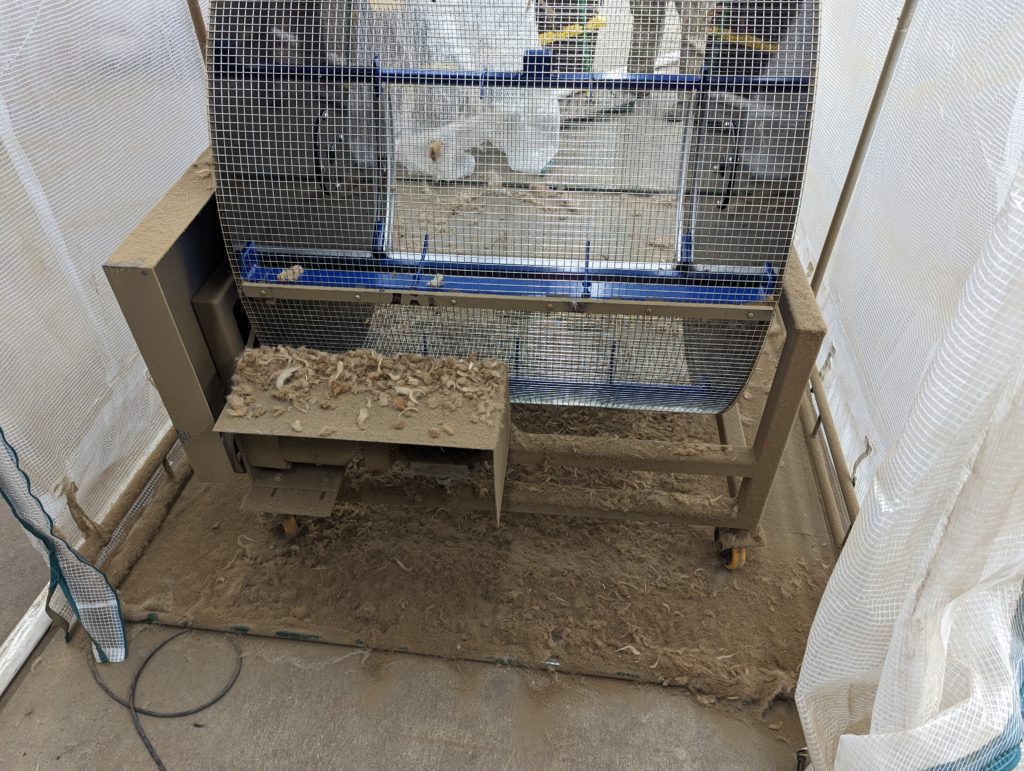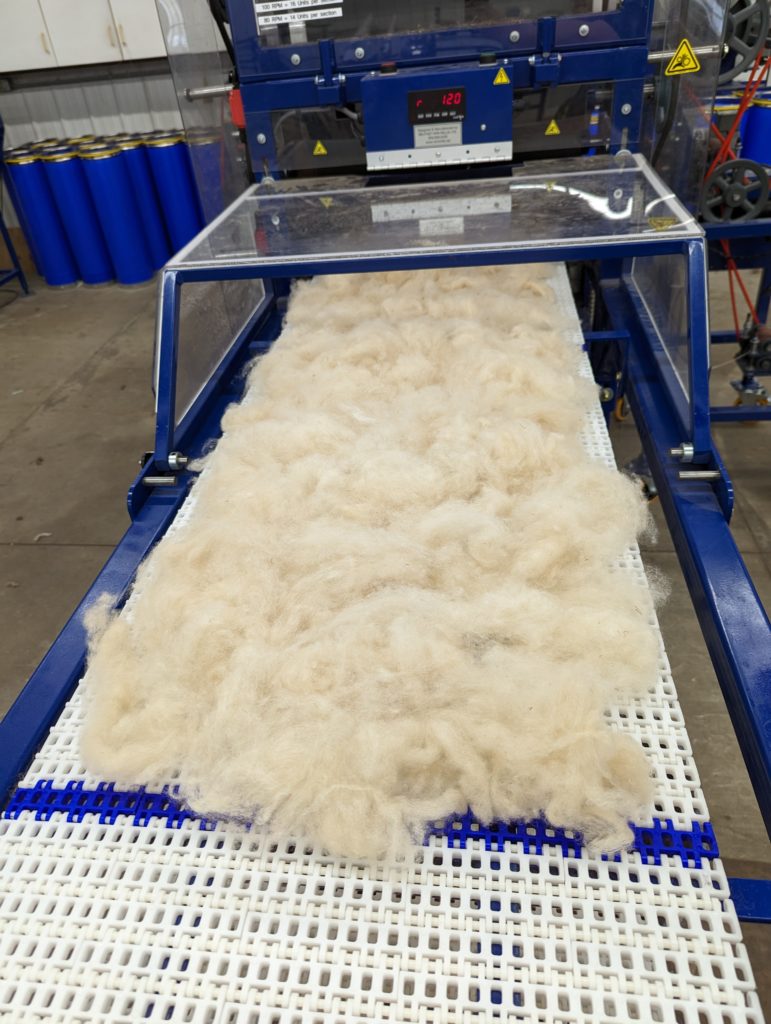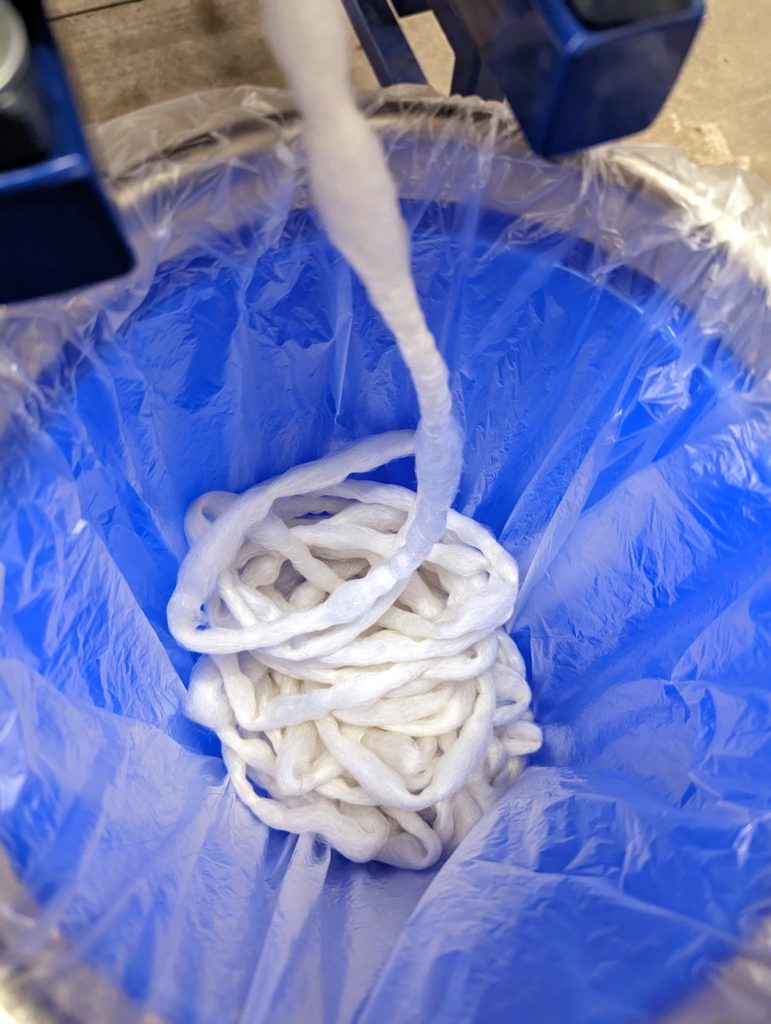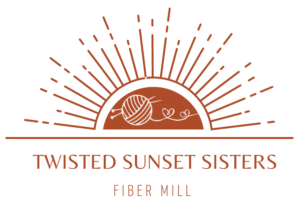Stages of Processing
Twisted Sunset Sisters Fiber Mill is thrilled to offer a number of products and services to our regional fiber arts and farming communities. Our services are fully customizable, whether you’re looking for a simple wash for a few fleeces, or a range of spinning products or finished yarn. We can help guide you through this process, and are happy to answer any questions you might have!

Fiber Processing:
Curious about how your fleeces will make their way through our mill? These are some photos and descriptions of the core processing steps used to produce some of the products offered at TSS!
Skirting:
This process should be completed before you send or drop off your fiber to TSS. This process involves laying out the fleece on a large table or surface and picking out any of the debris you see (also called vm or vegetable matter). Animals LOVE to roll around in hay, grass, etc and pick up a lot of “extra” bits throughout the year. As we charge by weight for our services, it benefits you to pre pick these bits and bobs out before processing as your processing fees will be lower (less weight) and the quality of your finished products will be higher as less VM will make its way into the finished products. Our machines can remove some VM, but nothing beats a good skirting!


Tumbling:
Our “Tumblerdome” (as we like to call it!) helps pre clean dusty or vm (vegetable matter) heavy fibers by spinning them around to knock loose a lot of these unwanted items before we wash. Tumbling can’t fix poor skirting, but it does really help improve the washing of dusty fibers like alpaca by knocking a lot of this loose beforehand!



Washing:
All fiber must be washed before it can be processed into anything. We recommend letting us washing your fiber with our industrial sized washer and specialized designed for fiber soap are perfectly designed to deep clean fibers of all types. For wool, this process melts the lanolin contained within it which makes the wool both sticky and water resistant. For other protein fibers (llama, mohair, angora, alpaca, etc.), this process removes the dirt and dust that comes from living outside year long.


Picking”
Picking fluffs up the naturally slightly matted fiber to make the individual fibers more lofty and ready for carding. By opening up the locks of the fiber small bits of debris (vegetable matter, hay, dirt, sticks, etc) will fall out. The picker pulls apart these locks and then throws the resulting fluff into a small enclosure for collect. Opening that picker door to see the fiber explosion is our favorite part!



Separating (optional):
This is an optional step of processing which really benefits super-fine fleece, fleeces containing a lot of grass/other vegetable matter (VM) or fleeces with a high quantity of guard hairs (thick, coarse fiber mixed in with the finer). Super-fine fleece can be too fragile for the picking process causing the picker to literally rip the fiber locks and cause little balls or bumps in the fiber called “neps.” The separator allows us to do this process more gently, but is much slower and requires us to break up the locks a bit by hand. Fiber with a small amount of VM will likely be fine skipping this step and going directly from the picker to the carder.



Carding
Carding aligns the fibers back into a general parallel structure. The end result can be made into either roving (a long, thin tube of fiber) or into batts (flat, square sets of fiber). Roving could be sold as-is to hand spinners, dyed, or processed further into yarn. Batts can also be sold to hand spinners, dyed, or felted into other products.
Products: Roving or Batts



Rug Yarn (Core-Spun):
This machine can be attached to the side of the carder and allows us to create a think yarn with fibers wrapping around a solid core strand. Typically this core is made from thick cotton with the carded fibers twisted around this to form highly textured yarn. This type of yarn is great for using wastes (mill ends) from the other machines as staple (lock) length isn’t really a factor here and coarser fibers are welcome! This type of yarn is used for rug-making, tapestry or other forms of yarn-related art.




Draw Frame:
The draw frame takes our roving and provides it more consistency. The draw frame takes 2 to 4 strands of roving, gently combs the fibers to be more aligned, and stretches out these strands of semi-aligned fibers into a more consistent typically thinner roving. If you like to spin finer yarns or like more consistent roving, you can add on this process for an additional charge.
Product: Pin Drafted Roving


Spinner
This machine takes up to 8 barrels of roving and transforms these into a single strand of yarn of various thicknesses. The bobbins produced from this machine can either be left as single ply yarn or combined into multi-ply yarn at the plyer.
Product: Single Ply Yarn



Plyer
The Plyer takes multiple strands of yarn and combines them into one strand. This is what most people think of when they think of yarn. A strand of yarn can be composed of 2-4 individual yarn singles. Gauges here are used to ensure our finished yarn is the appropriate weight (size) as well.
Product: 2 to 4 ply yarn.



Cone Winder & Steamer:
These two machines work together to take the above bobbins of single or multi-ply yarn, apply hot steam to them and winds them onto cones. Cones can be used as is for any arts or craft, and are popular for weavers. There is small fee per cone as they contain a cardboard cone center.
The steam applied helps to set the twist that was given to create the yarn and ensures it will not untwist once it’s used. One the yarn is steamed it is considered finished and ready for use. A final measurement is taken, called wraps per inch, which is a common measurement used to confirm the size or weight of the finished yarn.
Produces: Cones of yarn.



Skein Winder:
The skein winder takes cones or bobbins and winds them into traditional skeins. We aim for 3.5 to 4 oz per skein, a specific wraps per inch and overall yardage per skein. These are wrapped and twisted into hanks that are ready for sale. Due to the processing oils and spinning oils used however, we recommend adding a skein wash (or washing the skeins yourself) to remove any of these yarns and return them to their natural squishy glory!
Product: Yarn Skeins




Skein Wash:
This final wash of the yarn in skein form is highly recommended but not required for processing. This final wash uses a specially formulated fiber conditioner to add a nice clean scent to the yarn and strips out any remaining processing and spinning oils. If you’re a hand-processor, this is similar to the soak and snap/thwack process that’s done post-spinning to help the fibers bloom out. The result is knit-ready, soft yarn! If you opt to skip this process, we would recommend you hand wash the skeins after receiving them to remove any of the remaining oils and restore them to their natural glory!

Add-on Services
These add-on services are in addition to the core processing, and transform your roving/batts/yarn into a more finished, ready-to-use product. These costs can be variable where indicated, so please give us a call to discuss what you are looking to create.
Custom Dyeing:
We offer a number of different options for dyeing both roving/batts as well as finished skeins of yarn. We can provide both natural dyes as well as commercially-created acid dyes. These are processed in small batches in our dye vats. Colors may vary slightly between dye lots.
Custom Weaving:
Upon request, rug yarn or core-spun yarn can be further processed into finished woven products. We will offer a select set of rugs options as well as scarves or pillows which can be created based on availability and request.
